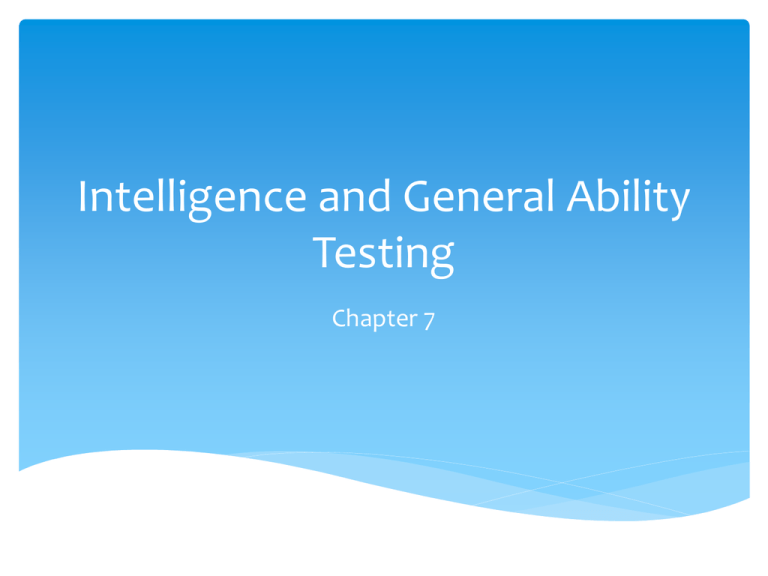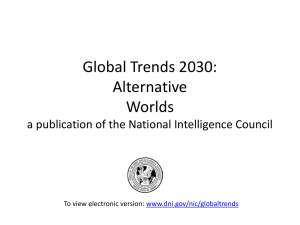Chapter 7 revised - Caroline Paltin, Ph.D. Licensed
advertisement

Intelligence and General Ability Testing Chapter 7 Models of Intelligence Psychometric approach Developmental progressions Information processing Other theories Psychometric Approach Based on premise that intelligence can be described in terms of mental factors (Bjorkland, 2005) Spearman’s two-factor model (1927) g (general ability factor) Specific factors Guilford’s structure-of-intelligence theory (1988) 180 intellectual factors in three dimensions: Mental operations Content areas Products Psychometric Approach (cont.) Thurstone’s 7 primary mental abilities (1938) Verbal comprehension Word fluency Number facility Perceptual speed Memory Space Reasoning Vernon’s hierarchical theory (1950) g Verbal and educational aptitude & spatial, mechanical and practical aptitude Cattell-Horn-Carroll Model One of the more influential contemporary theories g: top stratum Second stratum: Fluid abilities (Gf), crystallized abilities (Gc) & six other broad abilities Third stratum: more specific factors Developmental Progressions Developmental theorists posit that intelligence can be better understood by examining how intelligence develops Learning and environment influence the process Jean Piaget (1972) Stages of Development: Sensorimotor Preoperational Concrete Formal operations Developmental Progressions Jean Piaget (1972) (cont.) Intellectual functions: Assimilation Accommodation Ceci’s bioecological model (1990, 1993) Intellectual abilities are highly influenced by context in which they are performed Intelligence may not be reflected in methods currently used to assess intelligence Information-Processing These models focus on how individuals process information Luria’s theory (1966) Simultaneous processing Sequential processing Naglieri & Das’ theory (1997, 2005) Planning, Attention, Simultaneous and Successive (PASS) Sternberg’s triarchic theory (1985, 1988) Internal world of individual or mental processes that underlie intelligence Experiential subtheory Individual’s contextual or external world Other Theories Gardner’s theory of multiple intelligences (1993) Any set of adult competencies that are valued in a culture merits consideration as a potential intelligence 9 “frames of mind” 1. 2. 3. 4. 5. 6. 7. 8. 9. Linguistic Logical-mathematical Musical Spatial Bodily-kinesthetic Interpersonal Intrapersonal Naturalist Existential Measures need to value intellectual capacities in wide range of domains, methods should be appropriate for domain Individual Intelligence Testing Wechsler Scales Stanford-Binet Intelligence Scale Kaufman Instruments Woodcock-Johnson III Complete Battery Additional Individual Instruments Wechsler Scales Wechsler Adult Intelligence Scale – Fourth Edition (WAIS-IV, 2008) Wechsler Intelligence Scale for Children – Fourth Edition (WISC-IV, 2003) Wechsler Preschool and Primary Scale of Intelligence III (WPPSI-III, 2002) Wechsler Memory Scale IV (WMS-IV, 1997) WAIS-IV Full Scale IQ Index Scores: Verbal Comprehension (Vocabulary, Similarities, Information, Comprehension*) Perceptual Reasoning (Block Design, Matrix Reasoning, Visual Puzzles, Figure Weights*) Working Memory (Digit Span, Arithmetic, Letter-Number Sequencing*) Processing Speed (Symbol Search, Coding, Cancellation*) Uses basal and ceiling levels WISC-IV Full Scale IQ – based on four Index Scores: Verbal Comprehension Index •Similarities •Vocabulary •Comprehension •Information (supplemental) •Word Reasoning (supplemental) Working Memory Index •Digit Span •Letter-Number Sequencing •Arithmetic (supplemental) Perceptual Reasoning Index •Block Design •Picture Concepts •Matrix Reasoning •Picture Completion (supplemental) Processing Speed Index •Coding •Symbol Search •Cancellation (supplemental) Stanford-Binet Intelligence Test – 5 For use with individuals 2 – 85 years old Verbal IQ, Nonverbal IQ, Full Scale IQ Five factors for both verbal and nonverbal areas 1. 2. 3. 4. 5. Fluid Reasoning Knowledge Quantitative Reasoning Visual-Spatial Processing Working Memory Basal level, ceiling level, routing tests Kaufman Instruments Kaufman Assessment Battery for Children, Second Edition (KABC-II, 2004) Kaufman Adolescent and Adult Intelligence Test (KAIT, 1993) Not as widely used as Wechsler instruments Integration of different theoretical approaches KABC-II Designed to assess children ages 3 to 18 Yields 4 or 5 scales depending on whether the CattellHorn-Carroll (CHC) or Luria approach is used CHC perspective (Fluid-Crystallized Index) Short-Term Memory Visual Processing Long-term Storage and Retrieval Fluid Reasoning Crystallized Abilities Sequential Processing Simultaneous Processing Learning Ability Planning Ability Luria perspective (Mental Processing Index) KAIT Designed for individuals 11-85 years old 3 intelligence scales: Fluid (Gf) Crystallized (Gc) Composite 6 subtests: 3 assess fluid intelligence 3 assess crystallized intelligence Woodcock-Johnson III Complete Battery Assesses general intellectual ability, specific cognitive abilities, scholastic aptitude, oral language & academic achievement Comprised of two instruments: Woodcock-Johnson Tests of Cognitive Abilities Woodcock-Johnson Tests of Achievement Based on CHC model of intelligence Clusters: Verbal Ability, Thinking Ability, Cognitive Efficiency, Broad Reading, Broad Math, Broad Written Language, Oral Language Additional Individual Instruments Differential Ability Scales-Second Edition (Elliot, 2006) Slossen Intelligence Test-Revised, Third Edition (Nicholson & Hibpshman, 1990) Raven’s Standard Progressive Matrices (Raven et al., 1998) Peabody Picture Vocabulary Test, Fourth Edition (Dunn & Dunn, 2007) Test of Nonverbal Intelligence 3 (Brown et al., 1997) Group Intelligence Testing Given more often than individual intelligence tests, usually in schools Not as easy to monitor test-taker’s behavior during assessment Require more reading than individual tests Must consider other factors of individual (culture, background, language proficiency) when interpreting results Group Intelligence Testing (cont.) Cognitive Abilities Test (CogAT) Otis-Lennon School Ability Test, 8th Edition (OLSAT-8) Naglieri Nonverbal Ability Test (NNAT) Multidimensional Aptitude Battery II (MAB-II) Wonderlic Contemporary Cognitive Ability Test Is Intelligence Stable? Infants and young children have the least stable intelligence test scores Early research indicated intelligence gradually declines after age 20 – not supported by later research More recent research indicates intelligence gradually increases from childhood to middle age and then levels off Declines tend to occur in areas of fluid intelligence Degree of decline related to interaction of variables, such as physical health, mental activities, education What Do Intelligence Scores Predict? Intelligence tests appear to be related to academic performance (correlation of 0.5) The relationships among IQ scores, occupational success, and income are not simple Validity generalization Same test score data may be predictive for all jobs – if test is valid for a few occupations, it is valid for all jobs in that cluster GATB validity coefficients can be generalized to other occupations. Concerns regarding the use of the Job Family method and ethnically diverse groups Is Intelligence Hereditary? One of the most controversial issues in intelligence testing Difficult to determine estimates of genetic contribution to intelligence Heritability indexes for intelligence tend to be approximately .50 Both genetic and environmental factors affect intellectual development; IQ scores seemingly related to interaction between the two What Environmental Factors Influence Intelligence? Culture and language School attendance Quality of schooling Family environment Environmental toxins Are There Group Differences in Intelligence? Gender Do not appear to be general intellectual differences between men and women Men may be better at visual-spatial tasks Women may be better at some verbal tasks Ethnicity African-Americans, Hispanics, and Native Americans tend to score lower on intelligence tests than European-Americans or Asian-Americans Differences may be due to socioeconomic, linguistic, cultural factors, etc. What is the Flynn effect? James Flynn (1984, 1987) first to identify steadily increasing intelligence test scores in recent years Gains in IQ not reflected in gains in achievement Possible explanations: better nutrition, more test sophistication, changes in education and opportunities, changes in parenting practices









